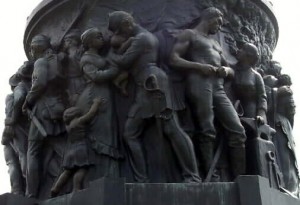Why memorials matter
 On Memorial Day, President Obama sent a wreath to the Confederate Memorial at Arlington National Cemetery, continuing a ritual observed annually since the administration of Woodrow Wilson (but briefly halted during the Bush I and Clinton years before being reinstated by Bush II). While the president chose not to address a letter from a group of historians that requested the abandonment of this long-standing practice, Obama also sent a wreath to the African-American Civil War Memorial located in Washington, D.C.
On Memorial Day, President Obama sent a wreath to the Confederate Memorial at Arlington National Cemetery, continuing a ritual observed annually since the administration of Woodrow Wilson (but briefly halted during the Bush I and Clinton years before being reinstated by Bush II). While the president chose not to address a letter from a group of historians that requested the abandonment of this long-standing practice, Obama also sent a wreath to the African-American Civil War Memorial located in Washington, D.C.
In doing so, Obama seemingly followed the advice offered by University of Pittsburgh art historian Kirk Savage published in an Op-Ed in the previous Saturday’s Washington Post. Acknowledging that the Confederate Memorial’s legitimacy rested on “the myth that the Confederacy somehow had higher, more abstract motives (‘state sovereignty,’ or, more ironically, ‘liberty’)” than the defense of slavery, Savage nonetheless argued that ending the wreath laying was politically unrealistic and, more importantly, by singling out only “the ordinary soldiers of the Confederacy as beyond the pale,” it would obscure the nation’s broad complicity in maintaining the peculiar institution and slavery’s “profound role” in America’s overall development. He therefore recommended instituting a new tradition: dispatching two wreaths that would not bear a message of reconciliation but, rather, of “reckoning with the racial divide that is slavery’s cruelest and most enduring legacy.”
Kirk’s Standing Soldiers, Kneeling Slaves (Princeton, 1997) is an outstanding study of memorials and the public representation of race (and his more recent stint as guest moderator in ASHP’s online Picturing U.S. History Forum offered truly exemplary approaches to critically using visual evidence to teach slavery), and his proposal is both practical and honestly reflective. I also applaud its positive result: the official, public recognition of the African-American troops who fought against slavery.
Nevertheless, President Obama’s wreath-laying equanimity also may have offered a confusing message. Actions, as the old saw goes, speak louder than words . . . but they sometimes end up being distressingly ambiguous without words to explain them. The president’s well-intentioned, Solomonic, and unremarked-upon gesture still leaves unaddressed and unchallenged a symbol of the Civil War that articulates the obscurantist myth of “The Lost Cause,” the vision of an imaginary antebellum South comprised of gentility, chivalry, and independence that served—and continues to serve—as a retroactive rationalization for the war. Indeed, it was the perpetuation of that myth (and the sotto voce racism underlying it) that was the motivation behind the creation of the Confederate Memorial in 1914 (as documented in Karen L. Cox, “The Confederate Monument at Arlington,” in Cynthia Mills and Pamela H. Simpson, eds., Monuments to the Lost Cause [Knoxville, 2003]).
To be sure, this matter involves the symbolic, that most tenuous and subjective of issues. But in the public’s persistently shaky understanding about the causes of the Civil War, symbols possess substantial resilience and salience—enough to lodge a troubling relativism in many a middle- and high-school classroom. While you will be unable to find any serious historical scholar who will lend credence to states rights, or the tariff, or other alternatve motives for southern secession that preclude its primary purpose, to defend the institution of slavery, you will find numerous history teachers who feel compelled to provide “balance” when teaching the causes of the Civil War. I fear that the Confederate Memorial and continuing official recognition, albeit inadvertent, of its message of “slavery denial” (a syndrome termed by historian Jeanie Attie) only contributes to continuing the mystification of the American past. And that is why I signed the above-mentioned appeal to President Obama.
Last 5 posts by Josh Brown
- The Civil War Draft Riots at 150 – A Public Event - June 17th, 2013
- Alfred F. Young - November 7th, 2012


